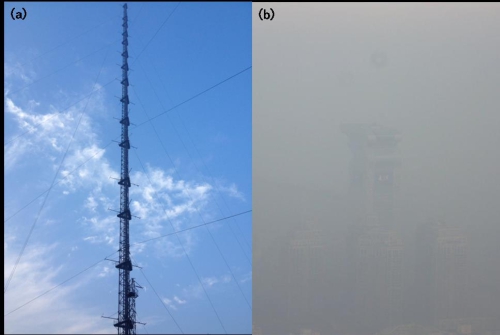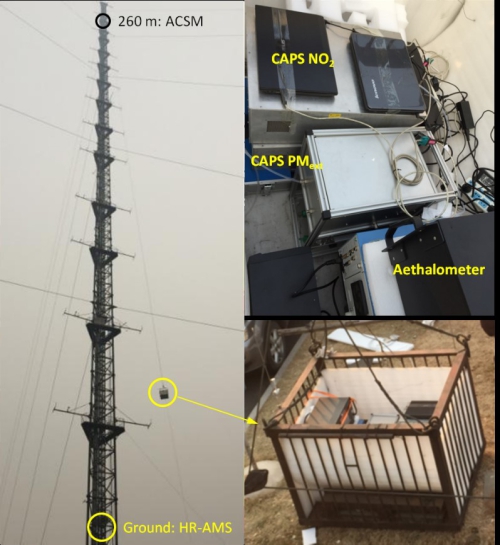Vertical Measurements of Air Pollutants in Urban Beijing
Date:2018-03-02
Severe haze episodes with surprisingly high concentrations of fine particles (PM2.5) still occur in fall and winter seasons in Beijing, although the air quality has been improved in recent years. Air pollution often shows strong vertical differences in Beijing. For example, we can feel fresh air with a good visibility at the peak of a mountain on a hazy day, while the city is actually buried in a low visibility and severely polluted air. In the urban area, we also often observe the coexistence of haze and blue sky (Figure 1).

Figure 1. Photos taken at (a) the ground level (up), and (b) 280 m (down) on the Beijing 325 m Meteorological Tower at 8:30 am, Nov. 21st, 2014. (The photo on the left was taken by SUN Yele; The photo on the right was taken by the camera installed on the Tower).
To gain an in-depth understanding of the vertical evolution characteristics of air pollutants within urban boundary layer, a team of the State Key Laboratory of Atmospheric Boundary Layer Physics and Atmospheric Chemistry, Institute of Atmospheric Physics, CAS, used a container that can travel on the Beijing 325 m Meteorological Tower for the vertically resolved measurements of light extinction coefficient of dry fine particles, gaseous NO2, and black carbon (BC) (Figure 2) from ground surface to 260 m during daytime, and 200 m at nighttime. Simultaneously, non-refractory submicron aerosol (NR-PM1) species including organics, sulfate, nitrate, ammonium and chloride, were measured at ground level and 260 m on the tower with an Aerodyne High-Resolution Aerosol Mass Spectrometer (HR- AMS) and an Aerosol Chemical Speciation Monitor (ACSM), respectively. Four distinct types of vertical profiles were illustrated, and the vertical convection as indicated by mixing layer height, temperature inversion, and local emissions are three major factors affecting the changes in vertical profiles.

Figure 2. The vertically resolved observation system based on the Beijing 325 m Meteorological Tower (instruments included CAPS-PMext, CAPS-NO2, and AE33). NR-PM1 species were measured simultaneously at ground level and 260 m on the tower with an Aerodyne HR-AMS and an ACSM, respectively. (Image by SUN Yele)
The team found that the temperature inversion coupled by the interactions of different air masses elucidated the "blue sky – haze" co-existent phenomenon as shown in Figure 1. The tower-based vertically resolved measurements prove to be essential supplements to lidar measurements with a blind zone, typically below 200 m. The findings have recently been published in Atmospheric Chemistry & Physics .
Reference :
Wang Q., Sun Y., Xu W., Du W., Zhou L., Tang G., Chen C., Cheng X., Zhao X., Ji D., Han T., Wang Z., Li J., Wang Z.. Vertically-resolved Characteristics of Air Pollution during Two Severe Winter Haze Episodes in Urban Beijing, China. Atmospheric Chemistry & Physics, 2018, 18(4): 2495-2509. https://www.atmos-chem-phys.net/18/2495/2018/acp-18-2495-2018.html
Contact: Ms. LIN Zheng, jennylin@mail.iap.ac.cn
